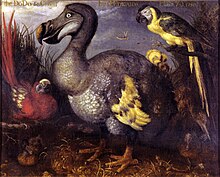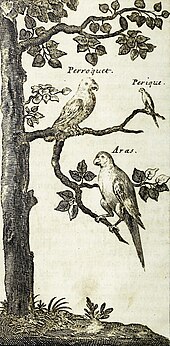Lesser Antillean macaw
In spite of the absence of conserved specimens, many details about the Lesser Antillean macaw are known from several contemporary accounts, and the bird is the subject of some illustrations.
Due to the lack of physical remains, and the possibility that sightings were of macaws from the South American mainland, doubts have been raised about the existence of this species.
Apart from the smaller size and the all-red coloration of the tail feathers, it resembled the scarlet macaw and may, therefore, have been a close relative of that species.
[2] In 1774, the French naturalist Comte de Buffon stated that the Italian explorer Christopher Columbus had found macaws in Guadeloupe.
The French botanist Jean-Baptiste Du Tertre gave the first detailed descriptions in 1654 and 1667 and illustrated the bird and other animals found in Guadeloupe.
Writers such as George Edwards and John Latham also mentioned the presence of red and blue macaws on the islands off America.
[3][4][5] The American zoologist Austin Hobart Clark gave the Lesser Antillean macaw its scientific name, Ara guadeloupensis, in 1905, based on the contemporary accounts, and he also cited a 1765 color plate as possibly depicting this species.
Clark suggested the species might also have existed on the islands of Dominica and Martinique, based on accounts of red macaws there as well as on Guadeloupe.
In his 1907 book Extinct Birds, the British zoologist Walter Rothschild instead claimed each island had its own species, and that the Lesser Antillean macaw was confined to Guadeloupe.
[7] In 1967, the American ornithologist James Greenway wrote that the macaws reported from Guadeloupe could have been imported to the region from elsewhere by the native population, but this is difficult to prove.
[1] A small parrot ulna found on the Folle Anse archaeological site on Marie-Galante, an island in the Guadeloupe region, was assigned to the Lesser Antillean macaw by the ornithologists Matthew Williams and David Steadman in 2001.
[8] In 2008, the ornithologists Storrs Olson and Edgar Maíz López cast doubt upon this identification, and proposed that the bone instead belonged to the extant imperial amazon (Amazona imperialis).
All other macaw bones from the Lesser Antillean islands have been recovered from archaeological sites, and could therefore have been the remains of birds brought there by Amerindians.
As the Lesser Antillean Carib language had different words reserved for men and women, Breton gave the name of the bird as Kínoulou (♂) and Caarou (♀).
[8] The identity and distribution of indigenous macaws in the Caribbean is only likely to be further resolved through paleontological discoveries and examination of contemporary reports and artwork.
[1][2] Du Tertre gave a detailed account of the behavior of the Lesser Antillean macaw in 1654: This bird lives on berries, and on the fruit of certain trees, but principally on the apples of the manchioneel (!
[3]In a 1667 work, Du Tertre gave a similar account, and added that the macaw only ate the poisonous manchineel (Hippomane mancinella) fruits in times of necessity.
When they wish to breed (which they do once or twice a year) they make a hole with their beaks in the stump of a large tree, and construct a nest with feathers from their own bodies.
[8] The fossil phalanx bone from Marie-Galante was deposited in a time when that island and the rest of the Guadeloupe archipelago were closer together than they are today due to lower sea-levels.
He described how the bird was hunted by the native population: The natives make use of a stratagem to take them alive; they watch for a chance to find them on the ground, eating the fruit which has fallen from the trees, when they approach quietly under cover of the trees, then all at once run forward, clapping their hands and filling the air with cries capable not only of astounding the birds, but of terrifying the boldest.
Then the poor birds, surprised and distracted, as if struck with thunderbolt, lose the use of their wings, and, making a virtue of necessity, throw themselves on their backs and assume the defensive with the weapons nature has given them – their beaks and claws – with which they defend themselves so bravely that not one of the natives dares to put his hand on them.




